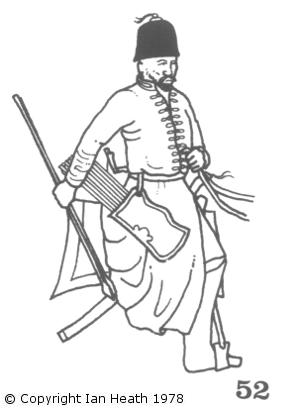Try Amazon Audible Premium Plus and Get Up to Two Free Audiobooks

Register a SNAP EBT card with Amazon
TURCOMAN TRIBESMAN
[based on Illustrations of Nomad Turkmen from Manuscript Hazine 2153 (Fatih Album), of the Saray Albums,
Topkapi Palace Museum, Istanbul Turkey]
An extract from Armies and Enemies of the Crusades 1096-1291
by Ian Heath

52. TURCOMAN TRIBESMAN
Turcomans (who still exist even today, under the name Turkmens) supplied the bulk of Seljuk armies,
as well as providing large numbers of auxiliaries to the late-Fatimids, Ayyubids, Mamluks and Ottomans.
Some even served with the Almohades in Spain and North Africa, where they were still called by their earlier name of Ghuzz.
Though they used some infantry armed with spear, sword and how they relied on their light horse-archers in battle.
This figure is based on the 14th century drawings of Ustad Mehmed Siyah Qalem, 13th century illustrations indicating that there had been no change of dress in the interim.
His topcoat shows the alternative upright-fastening rather than the oblique Muqallab flap generally worn by Turks.
Ustad Mehmed shows tunics chiefly in shades of blue, black, brown and red.
The black fur or felt cap is fairly standard.
Ibn Bibi, however, describing 13th century Karamanli Turcomans in Anatolia, speaks of red caps and black coats and boots.
Basic equipment appears to have consisted of bow, sabre and 2-3 light javelins.
In addition bags of loot were normally much in evidence.
Turcoman women also regularly fought alongside their menfolk, Marvazi comparing the Amazons to such female Turcoman warriors in the 12th century.
Much later (in the 15th century) one tribe is said to have raised as many as 30,000 female warriors.
Next: 53 & 54. BEDOUIN TRIBESMEN in Armies and Enemies of the Crusades 1096-1291 by Ian Heath


